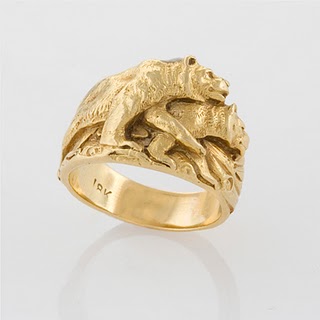Gustav Manz sketch for a polar bear scarfpin in 14K gold
Sold to Mrs. S.J. Farnham (Sally James Farnham) on December 26, 1914
Archived at Winterthur Museum Library
The day after Christmas 1914, artist Sally James Farnham purchased a small piece of jewelry from the studio of Gustav Manz: a scarfpin in the shape of a polar bear, nose held high. She may have thought of it for a gift, or to wear during opening ceremonies at the Panama-Pacific International Exposition in San Francisco where one of her bronzes—Cave Woman—would soon be on view at the Palace of Fine Arts. The golden California bear was a visual mascot for the fair, appearing on souvenir postcards, fobs, and other merchandise.
"Bear in Mind 1915"
Collection Burton Benedict
bearflatmuseum.org
This postcard for the California Insurance Company reminded tourists of the trauma behind the jubilance of the Exposition's host city
Collection Carol Brockfield
San Francisco had edged out New Orleans and Washington, D.C. in the competition to host the fair, and with the worrisome conflict unfolding in Europe, travel agents were busy booking their patrons for trips in the opposite direction. Rebuilding in the city after the great quake had progressed so rapidly that the fair became, in one historian's words, "a festival of self-congratulation and advertisement" encompassing such novelties as the bohemian-glass-clad Tower of Jewels and coffee brewed from beans shipped direct from South America via the Panama Canal. Ascending Mt. Tamalpais in a dinky railway car to see the redwoods and take in the view at the summit was all the rage; the year of the Exposition, 700 passengers road the train up the mountain daily.
Vintage postcard image of the Tower of Jewels at the 1915 Panama-Pacific International Exposition. The tower was clad in Novagems, free-swinging bits of cut glass that made the building shimmer madly
On February 20, President Wilson officially opened the exposition via wireless from the White House; the fair quickly broke all attendance records. Tiffany & Co. (where Sally's former husband, Paulding Farnham, had produced many of the firm's show-stopping jewelry designs) was represented by Louis Comfort Tiffany's Favrile glass vessels and a small exhibit in gold, enamel and precious stones. (A pendant necklace attributed to LCT and signed Tiffany & Co, and marked for the Panama-Pacific International Exposition, fetched $182,000 at Christie's Magnificent Jewels sale in April 2011.)
Gustav Manz sketch for a bear pin in platinum with diamond accents
Sold to Tiffany & Co in 1910
Archived at Winterthur Museum Library
Bear Ring carved in 18K, c. 1900s
Attributed to Gustav Manz
Photo Macklowe Gallery
A carved bear and oak leaves surround a star sapphire in this circa 1918 design. The buyer, Robert Hastings, was an associate of Walter P. McTeigue
Manz ledger, Winterthur Museum Library
Whether Gustav Manz visited the fair as a tourist or worked on jewelry for the exhibits is unknown. He probably profited from the hoopla surrounding the fair through sales of his bear motifs and other "Indian and Aztec" designs advertised in his jeweler's brochure. Buyers for these items included most if not all of the top retailers in New York: in addition to Tiffany & Co, sales are entered in Manz's ledgers for Marcus & Co, Gorham, F. Walter Lawrence, Black Starr & Frost, T. Kirkpatrick, and others.
Had he decided to make the trek, he might have stayed with his brother-in-law, Carl Bachem; one of the early National Park Service timber inspectors, Bachem lived with his wife Paula in Mill Valley, where many displaced quake victims took refuge. Assured of an expert wilderness guide, Manz's 22-year-old daughter Helen and her cousin Clara boarded the Transcontinental Railroad a few years later for a Grand Tour of the West. The girls brought a camera along and Clara filled an album with snapshots and snappy captions as well as postcards purchased at scenic points along the way.
No Bear Zone: Helen Manz seated "among the pepper trees" at the base of Mt. Tam with her maternal uncle Carl Bachem, in 1924; a timber expert for the Department of the Interior, Bachem worked with Stephen T. Mather and William Kent during the early years of the National Park Service
Seeing the entries in Manz's costbooks and the artifacts from Helen's and Clara's trip makes us eager to read a new book about the San Francisco fair: Empire on Display, by art historian Sarah J. Moore, to be published in May 2013. The fellow on the cover appears to be the earliest ticket holder. In fact, he is the exposition's other mascot, Hercules, completing his "13th labor" by muscling through the Culebra Cut (which opened the way for the Panama Canal) for a preview of The Jewel City's glass tower glittering in the distance.
Book jacket for Empire on Display (2013) based on the official poster
for the 1915 Panama-Pacific Exposition by California artist/lithographer Perham Wilhelm Nahl (1876-1935)
_________________________________________
Copyright © Laura Mathews, 2014
All Rights Reserved
GUSTAV MANZ LLC
gustavmanz.com
gustavmanz.com
__________________________________________
Special thanks to:
Research staff at Winterthur Museum Library
A. Richard Boera for preserving scrapbook of his mother's trip west with her cousin Helen
Other helpful sources:
Bejewelled by Tiffany 1837-1987, edited by Clare Phillips (Yale University Press)
Mount Tamalpais, A History by Lincoln Fairley (Scottwall Associates)
"Sailing to Byzantium: 1915 Panama Pacific International Exposition" by Gray Brechin
SallyJamesFarnham.org
Sierra Club Bulletin, Vol XI, No 2, January 1921, p. 216
SallyJamesFarnham.org
Sierra Club Bulletin, Vol XI, No 2, January 1921, p. 216




++copy+2.jpg)





